
The Guadiana River is an international river defining a long stretch of the Portugal-Spain border, separating Extremadura and Andalusia (Spain) from Alentejo and Algarve (Portugal). The river's basin extends from la Mancha and the eastern portion of Extremadura to the southern provinces of the Algarve; the river and its tributaries flow from east to west, then south through Portugal to the border towns of Vila Real de Santo António (Portugal) and Ayamonte (Spain), where it flows into the Gulf of Cádiz. With a course that covers a distance of 829 kilometres (515 mi), it is the fourth-longest in the Iberian Peninsula, and its hydrological basin extends over an area of approximately 68,000 square kilometres (26,000 sq mi).

The Douro is the largest river of the Iberian Peninsula by discharge. It rises near Duruelo de la Sierra in the Spanish province of Soria, meanders briefly south, then flows generally west through the northern part of the Meseta Central in Castile and León into northern Portugal. Its largest tributary is the right-bank Esla. The Douro flows into the Atlantic Ocean at Porto, the second largest city of Portugal.

A cable-stayed bridge has one or more towers, from which cables support the bridge deck. A distinctive feature are the cables or stays, which run directly from the tower to the deck, normally forming a fan-like pattern or a series of parallel lines. This is in contrast to the modern suspension bridge, where the cables supporting the deck are suspended vertically from the main cable, anchored at both ends of the bridge and running between the towers. The cable-stayed bridge is optimal for spans longer than cantilever bridges and shorter than suspension bridges. This is the range within which cantilever bridges would rapidly grow heavier, and suspension bridge cabling would be more costly.

The Sundial Bridge is a cantilever spar cable-stayed bridge for bicycles and pedestrians that spans the Sacramento River in Redding, California, United States and forms a large sundial. It was designed by Santiago Calatrava and completed in 2004 at a cost of US$23.5 million. The bridge has become iconic for Redding.

Ting Kau Bridge is a 1,177-metre (3,862 ft) long cable-stayed bridge in Hong Kong that spans from the northwest of Tsing Yi Island and Tuen Mun Road. It is near the Tsing Ma Bridge which also serves as a major connector between the Hong Kong International Airport on Lantau Island and the rest of Hong Kong. It was completed on 5 May 1998. The bridge is toll-free.

The 25 de Abril Bridge is a suspension bridge connecting the city of Lisbon, capital of Portugal, to the municipality of Almada on the left (south) bank of the Tagus River. It has a main span length of 1,013 metres (3,323 ft), making it the 48th longest suspension bridge in the world.
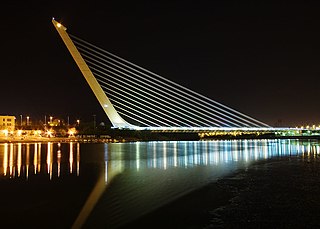
The Alamillo Bridge is a structure in Seville, Andalucia (Spain), which spans the Canal de Alfonso XIII, allowing access to La Cartuja, a peninsula located between the canal and the Guadalquivir River. The bridge was constructed as part of infrastructure improvements for Expo 92, which was held on large banana farms on the island. Construction of the bridge began in 1989 and was completed in 1992 from a design by Santiago Calatrava.

The Runyang Yangtze River Bridge is a large bridge complex that crosses the Yangtze River in Jiangsu Province, China, downstream of Nanjing. The complex consists of two major bridges that link Zhenjiang on the south bank of the river and Yangzhou on the north. The bridge is part of the Yangzhou–Liyang Expressway. Construction of the bridge complex began in October 2000 and was completed ahead of schedule. The bridge cost 5.8 billion Yuan. The complex opened to traffic on April 30, 2005. The total length of the bridge complex is about 35.66 kilometres (22.16 mi). In between the two bridges is the island of Shiyezhou.

An extradosed bridge employs a structure that combines the main elements of both a prestressed box girder bridge and a cable-stayed bridge. The name comes from the word extrados, the exterior or upper curve of an arch, and refers to how the "stay cables" on an extradosed bridge are not considered as such in the design, but are instead treated as external prestressing tendons deviating upward from the deck. In this concept, they remain part of the main bridge superstructure.
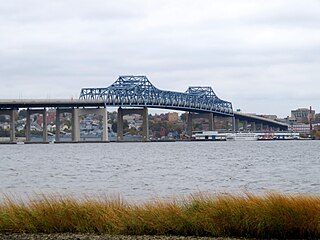
The Charles M. Braga Jr. Memorial Bridge, also known as the Braga Bridge, or simply, The Braga, is a through truss bridge that carries Interstate 195 over the Taunton River between the town of Somerset and the city of Fall River, near the mouth of the Quequechan River at the confluence with Mount Hope Bay. At just over a mile long, The Braga Bridge spans 1.25 miles (2.01 km) and is one of the longest bridges in Massachusetts. Opened to traffic on April 15, 1966, it provides an important link between Providence, Rhode Island, Fall River, New Bedford, and Cape Cod.

A stressed ribbon bridge is a tension structure similar in many ways to a simple suspension bridge. The suspension cables are embedded in the deck, which follows a catenary arc between supports. As with a simple suspension bridge, the weight is taken by the suspension cables, but unlike the simple span, the deck or ribbon is stressed in compression, which adds to the stiffness of the structure. The supports in turn sustain upward-thrusting arcs that allow the grade to be changed between spans. Such bridges are typically made from concrete reinforced by steel tensioning cables. Where such bridges carry vehicle traffic, a certain degree of stiffness is required to prevent excessive flexure of the structure, obtained by stressing the concrete in compression.
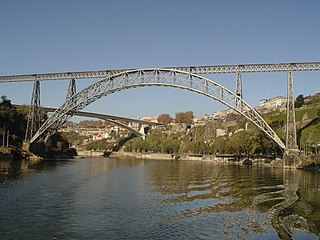
Maria Pia Bridge is a railway bridge built in 1877, and attributed to Gustave Eiffel, situated over the Portuguese Northern municipalities of Porto and Vila Nova de Gaia.

The Autovía A-49 is a major highway in Andalusia, Spain. It starts on the ring road of Seville and heads west with a spur south A-483 to Almonte, the Costa de la Luz and the Doñana National Park. The road crosses the Rio Tinto and the Odiel river north of Huelva and ends on the Portugal–Spain border 133 km west of Seville where it connects to the A22 motorway (Portugal) on the Guadiana International Bridge over the Guadiana River. It is also European route E1.
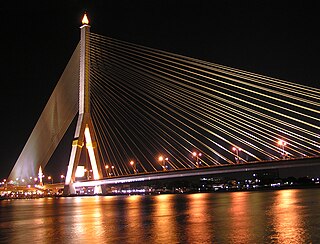
The Rama VIII Bridge is a cable-stayed bridge crossing the Chao Phraya River in Bangkok, Thailand. It was built to alleviate traffic congestion on the nearby Phra Pinklao Bridge. Construction of the bridge took place from 1999 to 2002. The bridge was opened on 7 May 2002 and inaugurated on 20 September, the birth anniversary of the late King Ananda Mahidol, after whom it is named. The bridge has an asymmetrical design, with a single pylon in an inverted Y shape on the west bank of the river. Its eighty-four cables are arranged in pairs on the side of the main span and in a single row on the other. The bridge has a main span of 300 metres (980 ft), and was one of the world's largest asymmetrical cable-stayed bridges at the time of its completion.

The Térénez bridge is a cable-stayed bridge, located between Landévennec and Rosnoën, Finistère, France.

The Lower Guadiana International Bridge is a bridge that crosses the Chança River connecting southern Spain and Portugal.
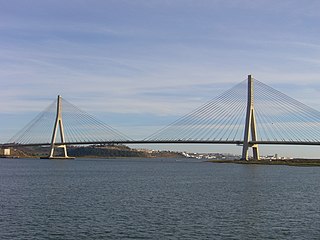
The Portugal–Spain border, also referred to as "The Stripe", is one of the oldest geopolitical borders in the world. The current demarcation is almost identical to that defined in 1297 by the Treaty of Alcañices. The Portugal–Spain border is 1,234 km (767 mi) long, and is the longest uninterrupted border within the European Union, being free of border control since March 26, 1995, with a few temporary exceptions, such as in the 2020 lockdown caused by the COVID-19 Pandemic.

The Dongshuimen Bridge and the Qiansimen Bridge, known collectively as the Twin River Bridges, are a pair of bridges that form a road and rail connection in Chongqing, China. Consisting of two cable-stayed bridges and a tunnel across the Yuzhong peninsula where the heart of Chongqing's commercial & financial district Jiefangbei CBD is located, the connection opened in 2014.

The Currents Bridge, is a tied-arch bridge that crosses the Lérez River in the city of Pontevedra, Spain. It was inaugurated in 2012 and connects Uruguay Avenue and Domingo Fontán Street.

The Tirantes Bridge is a cantilever spar cable-stayed bridge that crosses the Lérez River in the city of Pontevedra, Spain, linking the south bank to the north bank at the level of the city's Congress Hall.
























